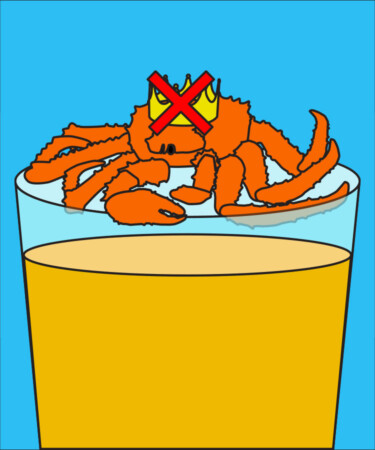This article is part of our Cocktail Chatter series, where we dive into the wild, weird, and wondrous corners of history to share over a cocktail and impress your friends.
If you’ve ever enjoyed a helping of succulent king crab legs with garlic butter and a glass of Champagne by the water — which we like to do as frequently as possible — it turns out that you’ve eaten an imposter. No, not imitation crab like the fake rubbery meat that you find in your gas station sushi rolls. But the “king crab” itself is actually not taxonomically a crab. (This isn’t the first time that a food’s nomenclature has steered us wrong — need we revisit the misleading nature of berries?) So, if king crabs aren’t crabs, what exactly are they? And why do they look so much like real crabs?
Well, examining the species’ evolutionary history without diving too deep into phylogenetic trees, it seems that the last common ancestor that king crabs shared with “true” crabs was about 250 million years ago, and they have since evolved into different taxonomic groups. Within the classification group Reptantia, which includes lobsters, crabs (real or fake), and some shrimp, there are several subdivisions, including the infraorder Anomura (fake crabs) and Brachyura (real crabs).
While at first glance the variations between the two classifications might not be apparent, there are a few differences to watch out for that can help determine whether or not a crab is an imposter. Crustaceans in the Brachyura group are known to have four pairs of walking legs while false crabs often only have three, and true crabs only have antennae between their eyes whereas false crabs have antennae elsewhere. A real crab’s carapace (the lid covering its head and upper body) is broad, flat, and wider than it is long, and these crabs will completely tuck their tails under them while you can usually spot the end of a false crab’s tail. In addition to the king crab, horseshoe crabs, porcelain crabs, and hermit crabs are all considered false crabs.
This brings us to the next matter: Why do these animals replicate the appearance of their better-known aquatic counterparts? For this, we will need a quick recap on convergent evolution. In biology class, lessons are mostly focused on the concept of divergent evolution, which is when different species branch out from a common ancestor, each developing separate traits that make them more and more different than one another — like how Darwin’s finches shared a common ancestor, but each adapted to its isolated environment in the Galapagos Islands with different- shaped beaks.
Alternatively, convergent evolution is when distinct species independently develop similar forms or traits, but not as a result of a common ancestor. Take birds and bats, for example. Both of these types of animals have wings and the ability to fly. But rather than deriving this from a shared relative, they individually evolved these skills as a solution to a problem — mainly avoiding land predators. The same goes for the fake crabs: The crustaceans in the Anomura classification separately evolved traits that make them look like crabs because they were faced with the same environmental challenges that created an adaptive pressure. For example, evolving a flatter, more crab-like body shape can lower the sea creature’s center of gravity, allowing it to escape predators faster.
So even though king crabs are technically just crab lookalikes, they remain a delicious pairing for some sparkling wine.
